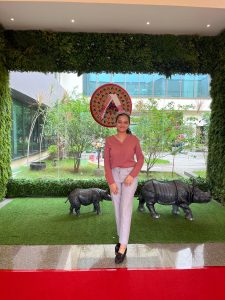 Brinda Kashyap (BK) from Guwahati, Assam has been recently honoured with the prestigious UNESCO Man and the Biosphere (MAB) Programme’s Young Scientist Award. Recognised for her pioneering research on rhino conservation and its socioeconomic impacts in Manas National Park, Kashyap employs advanced geospatial analysis and community engagement in her work. An alumna of St. Edmund’s College, Shillong, she is a National Geospatial Research Fellow at the Indian Institute of Technology, Bombay (IIT-Bombay).
Brinda Kashyap (BK) from Guwahati, Assam has been recently honoured with the prestigious UNESCO Man and the Biosphere (MAB) Programme’s Young Scientist Award. Recognised for her pioneering research on rhino conservation and its socioeconomic impacts in Manas National Park, Kashyap employs advanced geospatial analysis and community engagement in her work. An alumna of St. Edmund’s College, Shillong, she is a National Geospatial Research Fellow at the Indian Institute of Technology, Bombay (IIT-Bombay).
Kashyap is the sole recipient from India and one of 15 young scientists from 11 countries selected for the award, each receiving up to US$5,000 to support their research projects. Her research aims to simulate future habitat suitability and predict changes due to rapid climate change. The work addresses whether today’s habitats will remain suitable for wildlife in the next decade—a growing concern for national park animal populations.
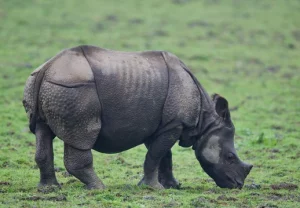 In Manas National Park, a UNESCO World Heritage Site, Brinda’s work will tackle the challenges the rhinoceros population faces. Her work leverages data from various sources including satellite imagery and blends technology into existing information. To ensure the feasibility of the finding, socio-economic impact and the effects of climate change are also taken into consideration.
In Manas National Park, a UNESCO World Heritage Site, Brinda’s work will tackle the challenges the rhinoceros population faces. Her work leverages data from various sources including satellite imagery and blends technology into existing information. To ensure the feasibility of the finding, socio-economic impact and the effects of climate change are also taken into consideration.
Sunday Shillong reached out to the young scientist to learn about her journey from a Geography graduate to a budding environmental conservationist who works with The International Union for Conservation of Nature (IUCN), World Wide Fund for Nature (WWF), IIT Bombay and now the UNESCO. Here are the excerpts from the conversation:
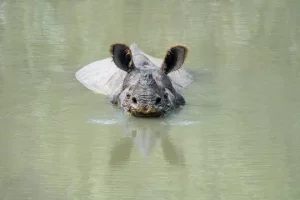 SS: Congratulations on winning the award and the grant! How do you feel about being the only one from the country to be selected for this award?
SS: Congratulations on winning the award and the grant! How do you feel about being the only one from the country to be selected for this award?
BK: It feels rewarding to have my efforts recognised, but this is just the first step. The main work starts now. I have always aimed to balance technology and research with socioeconomic analysis, and I believe this grant will help me achieve that goal.
SS: Can you tell us about your research that has been recognised and for which the award was granted?
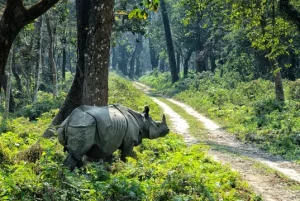 BK: I come from a Geography background and later ventured into Geoinformatics, but my interest has always been in environmental conservation. Since my Masters, I have been associated with institutions like IIT Bombay and the World Wildlife Fund (WWF), which have provided me a platform for my work. The current project, for which I received the award focuses on rhinoceros conservation in Manas National Park and conducting a socioeconomic impact assessment. My research integrates three main objectives: habitat suitability modelling, habitat change analysis, and climate change assessments. I am also developing a future land simulation model to predict changes in land use patterns in the national park. Additionally, I am conducting a socioeconomic analysis to understand the relationship between conservation work and local communities.
BK: I come from a Geography background and later ventured into Geoinformatics, but my interest has always been in environmental conservation. Since my Masters, I have been associated with institutions like IIT Bombay and the World Wildlife Fund (WWF), which have provided me a platform for my work. The current project, for which I received the award focuses on rhinoceros conservation in Manas National Park and conducting a socioeconomic impact assessment. My research integrates three main objectives: habitat suitability modelling, habitat change analysis, and climate change assessments. I am also developing a future land simulation model to predict changes in land use patterns in the national park. Additionally, I am conducting a socioeconomic analysis to understand the relationship between conservation work and local communities.
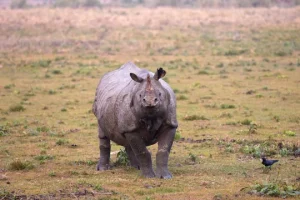 SS: What was your background as a student that made you interested in conservation?
SS: What was your background as a student that made you interested in conservation?
BK: I earned my Bachelor of Arts in Geography from St. Edmund’s College in Shillong. I then pursued a Master of Science in Geoinformatics from the Symbiosis Institute of Geoinformatics in Pune. In 2022, I participated in the FOSSEE Mapathon at IIT Bombay, where I secured third place in the national-level competition. That was the first step towards academia which led me to be interested in this field of work. Similarly, while doing my Master’s Degree, I was involved in a project in the Kaziranga landscape, and now I am working on Manas. Additionally, I am associated with the IUCN in the Meghna River Basin’s Water Futures Programme.
SS: Why are you specifically interested in rhino conservation?
BK: The one-horned rhinos found in Assam are a vulnerable species unique to our region. While various research has been conducted from zoological and environmental perspectives, there have been fewer studies from the geoinformatics field. I aim to contribute valuable work in this area that will be useful for policy and governance. My research seeks to apply technical and socioeconomic aspects to conservation efforts at the local level. I have been inspired by my supervisors and seniors to balance these aspects to ensure that my work is practical. I believe STEM (Science, technology, engineering, and mathematics) subjects and socioeconomic fields are interconnected, and my research will serve as a foundation for future studies.
SS: In simple terms, what do GIS and geospatial analysis mean?
BK: GIS (Geographic Information System) combines geography with IT (Information Technology). It allows us to apply theoretical knowledge using software, programming languages, and coding to create real-life visualisations of scenarios, which is very useful. GIS is crucial for projects like disaster management, urban planning, and forestry. Geospatial analysis provides a bird’s eye view of a particular area through satellite images or drone imagery, enabling various types of analysis like mapping and boundary management.
SS: How will the grant help you and your research?
BK: My research involves extensive fieldwork for data collection and surveys. I will use the funds to acquire software licences and field equipment, which will greatly facilitate my research.
SS: What does it mean to win the UNESCO Man and the Biosphere award, and what is the significance of this programme?
BK: The programme aims to train and connect young researchers on biosphere reserve conservation. It focuses on global conservation efforts for terrestrial and coastal or marine biospheres. I was selected in the terrestrial category for my research on Manas. This award is a significant milestone in my career, providing a platform to enhance and showcase my skills globally.
SS: What are the key challenges the rhinoceros population faces in Manas National Park, and how does your project address them?
BK: Poaching previously decimated the rhinoceros population in Manas. The government reintroduced them with red collars to track their movements and health. Environmental changes have affected their behaviour, and my research aims to understand these changes. The work is ongoing, and we are studying the current situation to develop effective conservation strategies.
SS: Assam is the only state in India with one-horned rhinos. Assam’s anti-poaching efforts have led to Kaziranga National Park exceeding its carrying capacity, resulting in the relocation of some rhinos to Manas, Pobitora, and Orang. Should Assam relocate some rhinos to neighbouring states with similar habitats?
BK: No, I don’t think that would be a good idea. Even though neighbouring states might have similar landscapes and climates, a very heterogeneous environment is necessary for rhino survival. Relocating or introducing rhinos to areas where they don’t naturally go could be detrimental.
SS: Poaching has been a significant issue. Do you think this problem is in the past, or do you envision a better future?
BK: Poaching, driven by the high value of rhino horns in black markets, especially in Southeast Asia, has been a major issue. However, poaching has declined, and 2022 was a “Zero-Poaching Year” for rhinos in Kaziranga. I believe the future looks better as there is a declining trend in poaching, and the government has enforced stricter norms against it in Assam’s national parks.
SS: Who have been your role models and mentors in your scientific journey, and how have they influenced your work?
BK: My high school Geography teacher, Juri Hazarika (Ma’am),introduced me to the GIS field and encouraged me to pursue it. I am also grateful to my college professors and the mentors and supervisors at my current institution who have guided and supported my research. They have played a significant role in shaping my career and helping me focus on impactful research.
SS: Any advice for aspiring environmental conservationists who want to become scientists?
BK: Conduct thorough research that doesn’t focus on just one aspect. Diverse perspectives are crucial. While technical reports and socio-economic studies may not always align, integrating both can lead to more impactful work. My mentors advised me to avoid relying solely on recent papers, as environmental conservation often differs in practice from theory. Therefore, choose research ideas that can be practically implemented.
Environmental conservation presents challenges, including implementation issues and concerns about how conservation efforts will affect locals whose livelihoods depend on forests and wildlife, such as those in the tourism sector. In Manas, a transboundary National Park sharing borders with Bhutan, humane conservation approaches are essential as they impact many lives.
(Interviewed by Jnanendra Das)



